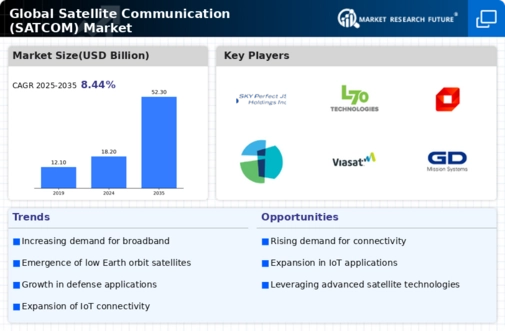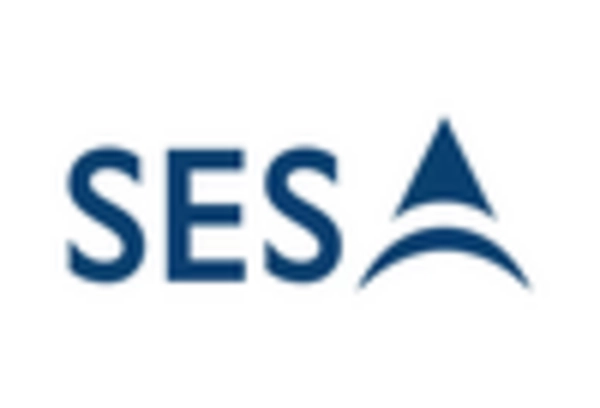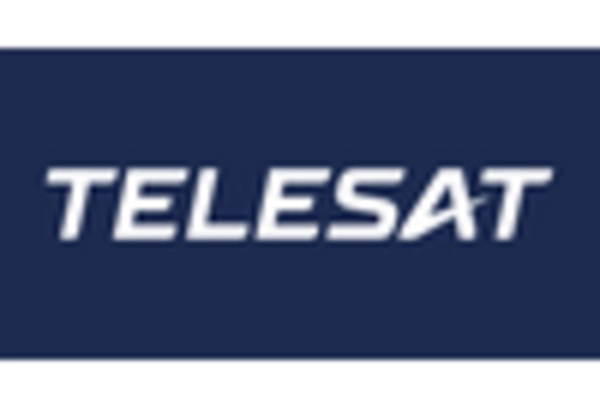Growing Demand for High-Speed Internet
The demand for high-speed internet connectivity continues to surge, particularly in remote and underserved regions. This trend is driven by the increasing reliance on digital services, including telecommuting, online education, and streaming services. The Global Satellite Communication (SATCOM) Industry is witnessing a notable shift as satellite operators expand their offerings to meet this demand. According to recent data, the number of satellite broadband subscribers is projected to reach over 10 million by 2026, indicating a robust growth trajectory. This growth is likely to be fueled by advancements in satellite technology, enabling higher data rates and improved service quality. As a result, The Global Satellite Communication (SATCOM) Industry is positioned to play a pivotal role in bridging the digital divide and enhancing connectivity across various sectors.
Rising Adoption of IoT and M2M Communication
The proliferation of Internet of Things (IoT) devices and machine-to-machine (M2M) communication is significantly influencing The Global Satellite Communication (SATCOM) Industry. As industries increasingly adopt IoT solutions for automation and data collection, the need for reliable communication networks becomes paramount. Satellite communication offers a viable solution, particularly in areas where terrestrial networks are inadequate. The market for satellite IoT is projected to grow substantially, with estimates suggesting a market size of over 5 billion USD by 2025. This growth is driven by sectors such as agriculture, transportation, and energy, where real-time data transmission is critical. Thus, The Global Satellite Communication (SATCOM) Industry is poised to capitalize on the expanding IoT ecosystem, providing essential connectivity for various applications.
Technological Advancements in Satellite Systems
Technological advancements in satellite systems are a crucial driver for The Global Satellite Communication (SATCOM) Industry. Innovations such as high-throughput satellites (HTS) and low Earth orbit (LEO) constellations are transforming the landscape of satellite communication. HTS technology enables operators to provide higher bandwidth at lower costs, making satellite services more competitive with terrestrial alternatives. Furthermore, LEO satellites are being deployed to reduce latency and enhance coverage, particularly in remote areas. The market for HTS is expected to reach approximately 20 billion USD by 2026, reflecting the growing interest in these technologies. As a result, The Global Satellite Communication (SATCOM) Industry is likely to experience accelerated growth driven by these technological advancements.
Expansion of Government and Military Applications
Government and military applications represent a substantial driver for The Global Satellite Communication (SATCOM) Industry. The increasing need for secure and reliable communication channels in defense operations has led to significant investments in satellite technologies. Military organizations are leveraging satellite communication for real-time data transmission, surveillance, and reconnaissance missions. Recent reports indicate that defense spending on satellite communication systems is expected to grow at a compound annual growth rate of 5% through 2027. This growth is attributed to the rising geopolitical tensions and the necessity for enhanced situational awareness. Consequently, The Global Satellite Communication (SATCOM) Industry is likely to benefit from these investments, as governments seek to modernize their communication infrastructures.
Increasing Investment in Satellite Infrastructure
Investment in satellite infrastructure is a significant driver of The Global Satellite Communication (SATCOM) Industry. As demand for satellite services escalates, companies are channeling resources into building and upgrading satellite networks. This trend is evident in the increasing number of satellite launches, with over 100 satellites expected to be launched annually in the coming years. Such investments are essential for enhancing capacity and expanding service offerings. Additionally, government initiatives aimed at promoting satellite technology development are further bolstering this investment landscape. The total investment in satellite infrastructure is projected to exceed 30 billion USD by 2027, indicating a robust commitment to advancing satellite capabilities. Consequently, The Global Satellite Communication (SATCOM) Industry stands to gain from this influx of capital, facilitating innovation and service expansion.



 Source Secondary Research, Primary Research, Market Research Future Database and Analyst Review
Source Secondary Research, Primary Research, Market Research Future Database and Analyst Review













Leave a Comment